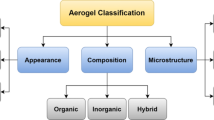Abstract
Silicate hybrid materials were prepared by the sol–gel process with the addition of x mass% of zirconium propoxide (x = 0 and 1). The thermal behaviour as well as the influence of Zr addition was studied by thermal gravimetric analysis and differential thermal analysis. The microstructure evolution with temperature was investigated by X-ray diffraction and small-angle neutron scattering. It was found that the beginning of polymer degradation occurs at a higher temperature in the material prepared with addition of Zr than in the one prepared without. At the nanometric scale, the materials prepared without Zr show smooth interfaces, whereas those with Zr present a mass fractal structure. This structure is also observed in the material without Zr after thermal treatment at 200 °C. The results showed that bioactivity is favoured by mass fractal structures in comparison with one consisting of smooth surfaces.







Similar content being viewed by others
References
Jarcho M, Kay JL, Gumaer RH, Drobeck HP. Tissue, cellular and subcellular events at bone-ceramic hydroxyapatite interface. J Bioeng. 1977;1:79–92.
Hench LL, Splinter RJ, Allen WC, Greenlee TK. Bonding Mechanism at the interface of ceramics prosthetic materials. J Biomed Mater Res Symp. 1971;2:117–41.
Kokubo T, Shigematsu M, Nagashima Y, Tashiro M, Nakamura T, Yamamuro T, Higashi S. Apatite- and wollastonite-containing glass-ceramics for prosthetic application. Bull Inst Chem Res (Kyoto Univ). 1982;60:260–2.
Hench LL, Wilson J. An introduction to bioceramics. Singapore: World Scientific; 1993.
Yan WQ, Nakamura T, Kobayashi M, Kim HM, Miyaji F, Kokubo T. Bonding of chemically treated titanium implants to bone. J Biomed Mater Res. 1997;37:267.
Chen Q, Kamitakahara M, Miyata N, Kokubo T, Nakamura T. Preparation of bioactive PDMS-modified CaO–SiO2–TiO2 hybrids by the sol-gel method. J Sol Gel Sci Technol. 2000;19:101–5.
Schmidt H. New type of non-crystalline solids between inorganic and organic materials. J Non Cryst Solids. 1985;73:681–91.
Mackenzie JD. Structures and properties of Ormosils. J Sol Gel Sci Technol. 1994;2:81.
Tsuru K, Ohtsuki C, Osaka A, Iwamoto T, Mackenzie JD. Bioactivity of sol-gel derived organically modified silicates, Part I: in vitro examination. J Mater Sci Mater Med. 1997;8:157–61.
Yabuta T, Bescher EP, Mackenzie JD, Tsuru K, Hayakawa S, Osaka A. Synthesis of PDMS-based porous materials for biomedical applications. J Sol Gel Sci Technol. 2003;26:1219–22.
Nabiça MSMS, Silva AMB, Miranda Salvado IM, Fernandes MHV, Margaça FMA. Híbridos Orgânicos-Inorgânicos com potencial aplicação como materiais para implantes ósseos. In: Proceedings of VI Congresso Luso-Moçambicano de Engenharia. Maputo. Moçambique (to be published).
Strunz P, Mortensen K, Janssen S. SANS-II at SINQ installation of the former Risø-SANS facility. Physica B Condens Matter. 2004;350 (1–3) (Suppl 1):E783–6.
Portela Marques MM, Miranda Salvado IM, Margaça FMA, Ferreira LM. The role of zirconium as thermal stabilizer of PDMS-TEOS hybrids. J Therm Anal Calorim. 2010;100:557–61.
Schilling F, Gomez MA, Tonelli AE. Solid-state NMR observations of the crystalline conformation of poly(dimethylsiloxane). Macromolecules. 1991;24:6552–3.
Pickup DM, Mountjoy G, Wallidge GW, Newport RJ, Smith ME. Structure of (SiO2)x(SiO2)1−x xerogels (x = 0.1, 0.2, 0.3 and 0.4) from FTIR, 29Si and 17O MAS NMR and EXAFS. Phys Chem Chem Phys. 1999;1:2527–33.
Meiszterics A, Rosta L, Peterlik H, Rohonczy J, Kubuki S, Henits P, Sinkó K. Structural characterization of gel-derived calcium silicate systems. J Phys Chem A. 2010;114:10403–11.
Brinker CJ, Scherer GW. Hydrolysis and condensation II: silicates. In: Sol–gel science—the physics and chemistry of sol-gel processing. San Diego: Academic Press Inc.; 1990. p. 192–193.
Rea SM, Best SM, Bonfield W. Bioactivity of ceramic–polymer composites with varied composition and surface topography. J Mater Sci Mater Med. 2004;15:997–1005.
Chen X, Nouri A, Li Y, Lin J, Hodgson PD, Wen C. Effect of surface roughness of Ti, Zr, and TiZr on apatite precipitation from simulated body fluid. Biotechnol Bioeng. 2002;101:378–87.
Schaefer DW. Fractal models and the structure of materials. MRS Bull. 1988;8:22–7.
Keefer KD. Growth and structure of fractally rough silica colloids. In: Brinker CJ, Clark DE, Ulrich DR, editors. Better ceramics through chemistry II. Pittsburgh, PA: Materials Research Society; 1986. p. 295–304.
Gomes SR, Margaça FMA, Ferreira LM, Miranda Salvado IM, Falcão AN. Hybrid PDMS–Silica–Zirconia materials prepared by γ-irradiation. Nucl Instrum Methods Phys Res B. 2007;265:114–7.
Acknowledgements
The work was based on experiments performed at the Swiss spallation neutron source SINQ, Paul Scherrer Institute, Villigen, Switzerland, and it was supported by the FCT (Portuguese Foundation for Science and Technology).
Author information
Authors and Affiliations
Corresponding author
Rights and permissions
About this article
Cite this article
Lancastre, J.J.H., Margaça, F.M.A., Ferreira, L.M. et al. Thermal analysis and SANS characterisation of hybrid materials for biomedical applications. J Therm Anal Calorim 109, 413–418 (2012). https://doi.org/10.1007/s10973-011-1459-z
Received:
Accepted:
Published:
Issue Date:
DOI: https://doi.org/10.1007/s10973-011-1459-z




